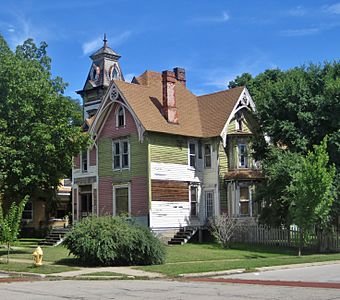Haight Village Historic District facts for kids
Quick facts for kids |
|
|
Haight Village Historic District
|
|

326 South Third Street, an 1883 Gothic Revival house with a Second Empire tower
|
|
| Location | Roughly bounded by Walnut & Kishwaukee Sts., Chicago Northwestern RR tracks & Madison St., Rockford, Illinois |
|---|---|
| Area | 42.4 acres (17.2 ha) |
| Built | 1843 |
| Architect | Multiple |
| Architectural style | Classical Revival, Greek Revival, Late Victorian |
| NRHP reference No. | 87002044 |
| Added to NRHP | November 20, 1987 |
The Haight Village Historic District is a special area in Rockford, Illinois. It shows how the city first grew and developed its neighborhoods. This district is like a time capsule, preserving many old homes and buildings.
Contents
Exploring Haight Village's Past
How Rockford Began
Rockford, Illinois, started out in 1834. A person named Germanicus Kent set up the first settlement on the west side of the Rock River. The very next year, Daniel Haight started another town on the east side of the river.
In 1839, these two towns joined together and became one city called Rockford. The Haight Village Historic District is where the first buildings on the east side of the river were built.
Oldest Homes and Growing Pains
The oldest building still standing in the district is the Wheeler cottage, built in 1843. You can also find two other old houses from the late 1840s at 314 South Second Street and 405 South First Street. Rockford grew super fast! In 1839, only 235 people lived there. By 1850, the population had jumped to 1,500!
Important People and New Neighbors
Many early homes in Rockford were built by John Lake. He owned a lumberyard and worked as a carpenter. He lived in Haight Village from when his house was built until 1874.
Another important person was Judge William Brown. He was the mayor of Rockford and also served in the Illinois General Assembly, which makes laws for the state. He moved to the district in 1858.
After the American Civil War, many people from Sweden moved to the United States. Haight Village became a lively Swedish community. John Erlander, a Swedish immigrant, became a very successful business leader in Rockford. He started two furniture companies. His house, built in 1871, is now a museum! You can visit it to learn about Swedish history in Rockford.
Beyond Homes: Factories and Schools
While Haight Village is mostly about homes, it also has some interesting non-residential buildings.
The Rockford Watch Company factory building was built in 1873. It was part of a bigger industrial area along the river. This factory building shows the Italianate style of architecture. Even though some parts were added later, it's one of the few old factory buildings left from that time in Rockford.
Rockford Central High School was finished in 1905. It was the only high school in the city until 1940! Imagine everyone from Rockford going to the same high school.
The Haight Village was officially recognized as a historic district by the National Park Service on November 20, 1987. This means it's a special place worth protecting for future generations.



